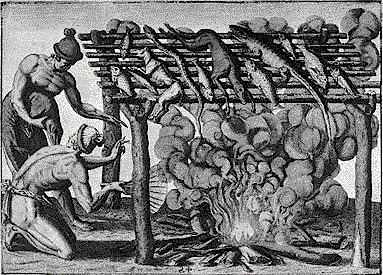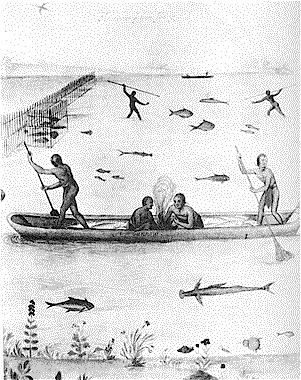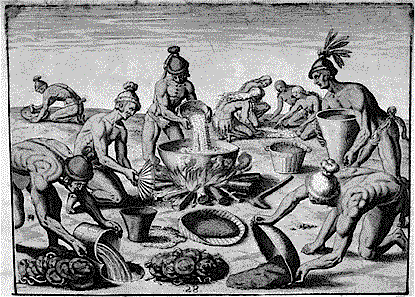Yat Kitischee – Reconstructing the Past
Archaeology doesn’t end when the digging stops. In fact, the excavation is just the beginning. For every hour spent digging, many more hours are spent in the laboratory washing, cataloging, and analyzing. The first step is to clean the artifacts and, if necessary, stabilize them to prevent their deterioration. Then they are sorted and cataloged. A computer is used to store all of the information associated with each artifact and feature. Computers also make it easier to analyze the many thousands of pieces of information that are generated from an archaeological project.
Different types of materials are analyzed by different specialists. For example, the Yat Kitischee Project employed specialists in lithic analysis, ceramic analysis, faunal analysis, bone and shell tool analysis, and botanical analysis. Charcoal and shell samples were sent to a special laboratory for radiocarbon dating.
Some of the most important information came from the analysis of the discarded bone and shell. These provided the archaeologists with information on the kinds of animal species that were used as food. The botanical analysis provided information on the kinds of plants that were present at the site. By examining and measuring the rims of the broken pot sherds, the different kinds of storage and serving vessels that were used at the site were identified. Use wear analysis determined what the different types of stone tools were used for.
How old is the site?
Radiocarbon dating was used to determine the age of Yat Kitischee. Using this method, scientists determined that the site was first occupied about 2000 years ago, or about 100 b.c., and continued to be used until about a.d. 1200. The archaeological evidence indicates that the site was used first by small groups camping for short periods of time. Around a.d. 100 people began to live at the site on a more permanent basis. It was at this time that the first structures were built. Sometime around a.d. 400 the northern portion of the site closest to the bay was abandoned and was used only for trash disposal. This may have been caused by higher sea levels or a higher water table. By a.d. 800 people had returned to this part of the site as evidenced by an increase in artifact density and the reappearance of pit features. The area was abandoned for good at about a.d. 1000 although other parts of the site continued to be used after this time. For example, a large shell mound was deposited sometime between a.d. 1000 and a.d. 1250, well after the northern part of the site was no longer being occupied.
Radiocarbon Dating
All living things absorb carbon which occurs naturally in three isotopes—12C and 13C, which are both stable, and 14C, which is not. Once an organism dies the unstable radioactive carbon 14C begins to decay at a known rate. It is possible to take a piece of charcoal, shell or bone, and by measuring the ratio of 14C to the stable isotope 12C, determine how much time has passed since the organism died.
What did they eat?

One of the most observable features at coastal middens is the large number of marine shells. At Yat Kitischee, over 16,000 pounds of shell were excavated from an area measuring only 44 square meters! Imagine how many shells must be contained in the entire 7 acre site! But even though shellfish are very numerous, they were not the most important species in the diet of the people who lived at the site. Mixed in with all the shell are many animal bones. By analyzing a sample of this material, archaeologists were able to identify a wide variety of fish, reptiles, birds, and mammals that were eaten along with shellfish. They were also able to determine the relative proportions that each class of animal contributed to the overall diet by estimating its biomass, or the quantity of edible meat weight available for each species represented at the site. Estimating the biomass of different species is an important part of reconstructing prehistoric diets. Why is this important? Consider for a moment that the edible meat weight of a single white-tailed deer is equivalent to the combined meat weight of 3,200 oysters! It is no wonder then that oysters far outnumber deer at the site. But more importantly, if only the numbers of oyster shell versus the number of deer bone were used to reconstruct the diet, the picture would be a very biased one. Biomass calculations help archaeologists draw a more accurate picture of what people ate. Using this method, archaeologists determined that 50-55% of the meat consumed at Yat Kitischee was fish, including catfish, trout, kingfish, jack, grouper, mullet, sheepshead, red and black drum (one sixty-pounder!), as well as sharks and sting rays. Oysters, whelks, clams, moon snails, and other shellfish accounted for about 35%. Surprisingly, reptiles such as turtles contributed about 8-10% to the native diet, more than mammals, birds and amphibians combined.
Fishing Technology

The inhabitants of Yat Kitischee no doubt relied heavily on the use of nets for fishing. Archaeologists used two types of evidence to make this inference. The size and composition of the individual fishes in the assemblage provide indirect evidence. For example, small fish such as menhaden and killifishes were probably incidental byproducts of using nets to capture targeted species such as drum, trout, mullet, and catfish. The species composition is also very similar to modern catches made under controlled conditions using gill nets. Direct evidence for the use of nets comes from several shell artifacts that are believed to have been used as net weights and net mesh gauges. Tidal traps and weirs may have also been used to capture fish in large quantities. Bi-pointed bone pins recovered from the site may have been used as throat gorges, a kind of primitive fish-hook.
How balanced was their diet?

Fish and shellfish provided the bulk of the caloric intake and an abundance of protein while turtles and terrestrial mammals were important sources of animal fat. What is not represented here is the contribution of plant foods to the overall diet. Many plants provided important vitamins and minerals that are not available in fish or other wild game. Some plants are particularly important sources of carbohydrates which are used by the body to produce energy. They would have been particularly important in a maritime economy since shellfish and many fish species typically have a low fat content. Unfortunately, plant remains do not preserve well unless they are charred. The only charred plant remains recovered from the site so far are fuel woods such as oak, pine, and cedar, so it is difficult to know precisely what species of plants were eaten at Yat Kitischee. Based on historical accounts of native plant use in the southeast, and botanical research at archaeological sites in south Florida, we can infer that the diet probably included naturally occurring plants that we know are edible and nutritious such as palmetto berries, blackberries, prickly pear fruit, hearts of palm, poke weed, purslane, the roots of Smilax and Coonti, acorns and hickory nuts, and the seeds of various wild grasses.
Did they practice agriculture?
Although the Spanish explorer Panfilio de Narvaez mentions corn at Tocobaga (Safety Harbor), there is no archaeological evidence to indicate that prehistoric or historic native peoples in the Tampa Bay area practiced intensive agriculture. There is evidence from southwest Florida of the cultivation of gourds, but these hard-shelled plants were probably used as containers and floats rather than as a food source.
There are several possible reasons why agriculture was not important in central and south Florida. One is that agriculture is found primarily in societies where population densities are high and natural sources of food are insufficient to feed large numbers of people. If the number and sizes of habitation sites are taken as a rough guide, then population density in the Tampa Bay area at circa a.d. 800 was probably not great enough to warrant the extra labor effort necessary to plant and tend crops on a large scale. Another factor is the high productivity of marine resources which makes it more efficient to intensify fishing and shellfishing to meet subsistence needs than practice agriculture. A third factor may have been poor soils which lacked the nutrients necessary for intensive agriculture.
What kind of houses did they live in?
The people who lived at Yat Kitischee approximately 1500 years ago lived in semi-circular structures that were constructed with a frame of wooden posts each measuring about 4–8 inches in diameter. One of these structures was excavated by archaeologists and its entrance opened to the northeast towards the bay. The structure itself was about four meters, or just over 13 feet, in diameter. We don’t know what they covered the structure with, but it was probably palm or palmetto fronds. Based on comparisons with hunter-gatherer-fishers in other parts of the world, a household of this size probably could have accommodated a family of 4-6 people. The area excavated was small, and there may have been other structures located nearby. Some of these may have been used for storage while others may have been dwellings. Based on the size of the site, Yat Kitischee may have contained anywhere from 8–10 of these households at one time for a total population of 30-60 people.
What kinds of tools did they use?
Prehistoric native peoples had to obtain everything they needed from their environment. They were ingenious in the ways that they used natural resources to construct their houses and make their clothes, tools, vessels, and ornaments. Because the people at Yat Kitischee lived close to the water, it is not surprising that many of their tools are made from marine shell. Large lightning whelks were attached to wooden handles and used as hammers and wood-working tools. Smaller crown conchs were also hafted and used as hammers. Sun ray venus shells made excellent scrapers for scaling fish or removing the bark from tree branches. Shell was also used to make dippers, cups, spoons, and ladles as well as net sinkers and net mesh gauges.
Stone was also used to make tools. The Florida stone used for tools is known as chert, which is simply limestone that has been replaced with silica. It is much like flint and the people of Yat Kitischee used it to make arrowheads, knives, scrapers, drills, and engraving tools. Most of the chert from Yat Kitischee was collected from prehistoric quarries around Tampa Bay.
Mammal bone was used to make projectile points, pins, and fish hooks. Several finely-carved bone pins were recovered at Yat Kitischee. A carved fossilized manatee rib was also found. Wood was probably used for a variety of things such as hammers, handles for tools, and digging sticks. Fibers made from palmetto fronds, grasses or root tendrils were probably used to make woven mats and baskets. Unfortunately, these more perishable materials are rarely preserved in Florida. We can infer their use at Yat Kitischee, however, based on their occurrence at sites where they have been preserved in wet, oxygen-free environments where no organisms can live to destroy them.
What did they call themselves?
The native peoples who lived in Florida left no written records so we have no way of knowing how they referred to themselves. The names given by archaeologists to the various prehistoric cultures are usually based on the sites where these cultures were first identified. When the Spanish explorers arrived in Florida, the names of the various tribes began to be recorded. The Tocobaga, Calusa, Tequesta, Mayaca, Ais, Pohoy, Mayaimi, Ocale, Potano, and Apalachee are just a few of the many tribes that inhabited the state in the early 16th century.
What kind of Pottery did they use?
Since Yat Kitischee was a village, the pottery found there reflects utilitarian uses- cooking, serving, and storage. Cooking and serving vessels tended to be shallow bowls with outward curving walls or deeper bowls with straight walls. Storage vessels tended to have walls that curve inward so that the opening was more restricted. Using a mathematical formula, rim sherds were used to accurately determine the size of the original vessels. Occasionally, vessels at Yat Kitischee were decorated with simple incised lines or with check-stamping, a surface design that was applied by pressing a carved wooden paddle into the wet clay before firing. Cord-marking, or the wrapping of a cord around a paddle and pressing it into the wet clay, was also used. Though these decoration techniques were represented at Yat Kitischee, the majority of the vessels were plain and undecorated. They were constructed by wrapping coils of clay atop each other and using sand for temper.
The Limitations of Archaeology
One part of native life that is difficult to reconstruct from archaeological evidence is the way that people perceived their world and their place in it-in other words, their belief systems. In traditional societies, many aspects of daily life are invested with a spiritual character. To the extent that these spiritual beliefs were manifested in behaviors that left behind material remains that can be interpreted accurately, archaeologists can attempt to reconstruct them. But we will never be completely successful. This is why it is important to work with and learn as much as we can from traditional peoples living today, so that we can bring their perspectives to bear on understanding the intricacies of past cultures.